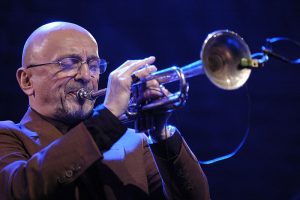A grand occasion for a towering figure in Polish music. Tomasz Stańko has founding father status as one of the post-war players who fostered the significant growth of jazz in the Eastern European country whose scene has since seen the emergence of several other feted champions.
jazzwisemagazine.com Fittingly, the 75-year-old trumpeter leads a quartet comprising musicians half his age, but the other major selling point of the gig is the presence of the NFM Philharmonic Orchestra, arranged and conducted by Krzysztof Herdzin.
Those with long memories will know that Stańko worked with the pioneering Globe Unity Orchestra back in the 1970s, and that he has always shifted astutely between post-bop and avant-garde pathways. Hence the prospect of hearing his broad, at times brash, at times plaintive tone cast against a stage full of strings and horns is mouth-watering. The majesty Stańko has often been able to evoke in his vast discography, above all on highlights such as 1976’s Fish Face and 1999’s Litania, his urbane take on the music of Krzystof Komeda, the iconic, enduringly influential composer with whom he worked in the 1960s, should lend itself well to such a dignified setting.

So it proves intermittently. Backed by drummer, Michal Miskiewicz, double-bassist Slamowir Kurkiewiczand pianist Dominik Wania, Stańko, a master of what he himself termed the ‘heavy ballad’, projects commandingly in the 1,800 capacity concert hall, which is sold out, and the airy, swish strains provided by the orchestra serve to heighten that, bringing out the precise, dry crackle of his brass all the more. While the mysterioso, sombre grace of Ascenseur-era Miles is part of his vocabulary Stańko has a hard, if not austere turn of phrase that is utterly gripping at times. The set-list comprises excellent material from recent works with his New York Quartet such as ‘Dernier Cri’ and ‘Wislawa’, which the band negotiates well, handling the buoyant swing and lithe, looser, more metrically open passages with a deft touch. Pianist Wania takes fine solos on which his harmonic finesse is matched by carefully channelled rhythmic drive from bassist Kurkiewicz and drummer Miskiewicz.
Sadly, there is a major problem with the arrangements. The horns are mostly underused, and the biggest disappointment is the inappropriately saccharine preludes and interludes on some pieces that stray far from the innate character of the band, to the extent that when the quartet is left alone without the orchestra the performance is enhanced rather than impoverished. The rest of the set has some beautiful melodies – ‘The Street Of Crocodiles’, ‘Oni’, ‘April Story’ – but the sense of imbalance between the orchestra and the band is a shame, given the potential of the meeting on paper.
Having said that, Stańko, radiating charisma in a bright red beret and slick dark suit, plays too lyrically for the concert not to engage a highly responsive and openly appreciative audience. Last year I was lucky enough to see him play with his New York quartet at Gateshead and the performance, marked by superb interplay and probing improvisations, was brilliant. This Polish band is also excellent, but the question is, how can a soloist of Stanko’s immense stature be most adequately served in an orchestral setting in one of the best concert halls in the world? There are hints of an answer tonight, but the enquiry on ‘Stańko symfonicznie’ shouldn’t stop here.
– Kevin Le Gendre; http://jazzwisemagazine.com
– Photos by Karol Sokołowski







More Stories
CD review: George Benson – Dreams Do Come True: When George Benson Meets Robert Farnon – 2024: Video, CD cover
The band was tight as ever. The Warren Haynes Band cuts loose: Video, Photos
Interview with Alvin Queen: Feeling Good – I heard these tunes played by … Video, new CD cover, Photos